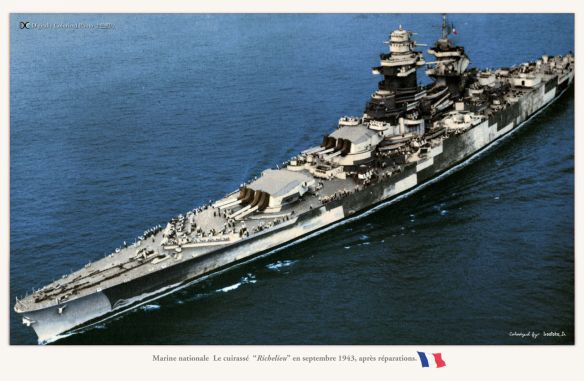The Richelieu was a French battleship launched in 1939; this one and her twin Jean Bart were built as a response to the Italian Littorio class and conceived …
The last French battleships, the impressive Richelieu and Jean Bart, were launched in 1939 and 1940, respectively. They, too, like the Dunkerques, grouped their main eight 15-inch gun battery forward in two turrets; their careers were hardly less checkered. Richelieu, 95 percent complete at the time of France’s surrender, was ordered to Dakar, North Africa, and there was damaged by British naval air attacks and beat off the elderly British battleship Resolution. Richelieu later went over to the Free French, proceeded to the United States for a major refit, and ended the war as France’s only capital ship in the Pacific, attached to the British Eastern Fleet in 1944-1945.
Jean Bart, the last French battleship, was about 77 percent complete in July 1940. It nonetheless escaped to Casablanca under its own power and in November 1942 was hit by aerial bombs and by five 16-inch shells from Massachusetts. Surviving the war, Jean Bart took its initial trial runs as late as 1949 and participated in the 1956 Anglo-French-Israeli Suez operation, bombarding Egyptian shore facilities. Jean Bart was thus the world’s last battleship to be completed and the last non-U. S. battleship to see action.
BB Richelieu
To maintain its position relative to other major navies, the French navy authorized two 35,000-ton battleships in 1935, to be named Richelieu and Jean Bart. They were basically enlarged editions of the 26,000-ton battlecruisers Dunkerque and Strasbourg, also with high speed and two quadruple turrets forward, but much heavier armament and protection.
The design which emerged was unique, with two large quadruple turrets well forward and widely spaced, and an ugly backward-angled funnel forming part of the after superstructure. They were, however, powerful and well-protected ships and their only drawback was low endurance, a result of being intended to operate primarily in the Mediterranean.
The Richelieu bore a charmed life, for she was running her trials at Brest when France fell in June 1940, but managed to escape to North Africa. She went to Dakar, and escaped without damage when a British motor launch tried to drop four depth charges under her stern. Early on the morning of 8 July she was attacked by six Fairey Swordfish torpedo bombers from HMS Hermes. One 457-mm (18-in) torpedo struck the Richelieu’s stern, and flooding caused her to settle on the bottom of the harbour. However, her 380-mm (15-in) guns were still functioning, and accurate salvoes helped to defeat an attack by British and Free French forces in September despite the fact that the ship was unable to steam, and that three of her guns were unable to fire.
As soon as her refit was completed the ship sailed to the UK via Toulon, and joined the Home Fleet at Scapa Flow, covering convoys to Murmansk and working up to full efficiency. In March 1944 she left the Home Fleet and was sent to Trincomalee to serve with the Eastern Fleet, She saw no great battles but took part in a number of bombardments and came under air attack on several occasions. Apart from a short refit at Casablanca from October 1944 to January 1945 she remained in the East Indies until October 1945, when she sailed for Indo-China.
Construction: Richelieu: Arsenal de Brest (October 1935-July 1940); Jean Bart: A. C. de St. Nazaire-Penhoet (January 1939-January 1949); (Two other sister ships were authorized: Clemenceau was canceled when 10 percent complete; Gascoigne never laid down.)
Displacement: 38,500-49,850 (average of the two)
Dimensions: 794′ x 813’2″ x 31’7″ (average of the two)
Armament: 8 x 15″ in 4 x 2-gun turrets
Armor: 13.5″ belt; 16.9″ main turrets; 5.9″-6.7″ main deck
Machinery: 4 x shaft Parsons geared turbines = 150,000 shp = 30 knots; Jean Bart 165,000 shp = 32 knots
Complement: Richelieu, 1,670; Jean Bart as flagship, 2,134
Fate: Richelieu: scrapped 1964; Jean Bart: not completed until after World War II, scrapped 1970.
